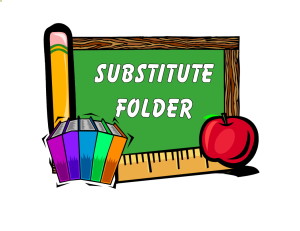[fusion_builder_container hundred_percent=”yes” overflow=”visible”][fusion_builder_row][fusion_builder_column type=”1_1″ background_position=”left top” background_color=”” border_size=”” border_color=”” border_style=”solid” spacing=”yes” background_image=”” background_repeat=”no-repeat” padding=”” margin_top=”0px” margin_bottom=”0px” class=”” id=”” animation_type=”” animation_speed=”0.3″ animation_direction=”left” hide_on_mobile=”no” center_content=”no” min_height=”none”]
We’ve all been there. A few minutes before you are to leave for work, one of your children suddenly becomes ill, you receive a phone call about a family emergency, your car will not start, or some other catastrophe happens that requires you to take an unexpected day off from work. You need a substitute and you need one fast! During times like this, especially if you are the one who is ill, writing substitute plans is not only the last thing you want to do, but can be quite difficult or next to impossible.
Investing the time in planning for such occasions before the school year even starts is wise, and you will appreciate it later when calamity hits. Here are five hints for planning for a substitute to give you peace of mind when you cannot be at school and to make the day run smoothly for both the substitute and the students.
Helpful Hints for Planning for a Substitute Teacher
[/fusion_builder_column][fusion_builder_column type=”1_1″ background_position=”left top” background_color=”” border_size=”” border_color=”” border_style=”solid” spacing=”yes” background_image=”” background_repeat=”no-repeat” padding=”” margin_top=”0px” margin_bottom=”0px” class=”” id=”” animation_type=”” animation_speed=”0.3″ animation_direction=”left” hide_on_mobile=”no” center_content=”no” min_height=”none”]
1. Have a binder with all necessary information for your classroom. This would include a student roster, a seating chart, your daily schedule, schedule for special classes (art, music, gym, etc.), fire drill procedures, bathroom and nurse procedures, your list of duties (lunch/cafeteria duty, recess, bus duty, study hall, etc.), morning procedures (attendance, morning work, circle time, calendar time), lunch procedure, dismissal procedure, a list of helpful students, teachers who can assist, your discipline policy and procedures, and anything else you can think of. Having a list of students who leave the room for a pull-out, speech therapy, etc. is also helpful. Keep this binder on your desk or on a bookshelf that is easily accessible. Don’t forget to update the binder throughout the year as you will change seating arrangements, have new students, and may change your schedule. The goal should be to keep the day as normal and consistent as possible for your students and to make the substitute’s job just a little easier.
Click here for tip #2.

